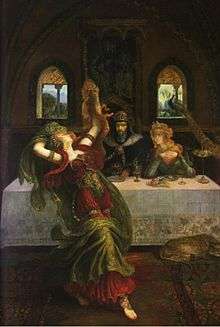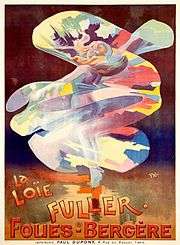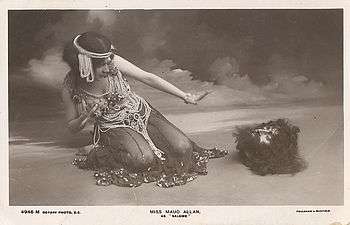Dance of the Seven Veils

The Dance of the Seven Veils is a term used to refer to the dance performed by Salome before Herod Antipas. It is an elaboration on the biblical story of the execution of John the Baptist, which refers to Salome dancing before the king, but does not give the dance a name.
The name "Dance of the Seven Veils" originates with the 1893 English translation of Oscar Wilde's 1891 French play Salome in the stage direction "[Salome dances the dance of the seven veils.]".[2] The dance was also incorporated into Richard Strauss's opera Salome. Wilde's choice of title for the dance has been linked to the popularity of orientalist "veil dances" in the period and to the emergence of striptease acts.
Biblical account
According to ten verses of Matthew 14, John was imprisoned for criticizing King Herod Antipas's marriage to Herodias, the former wife of Antipas's half-brother Herod II. Herod offered his niece a reward of her choice for performing a dance for his guests on his birthday. Herodias persuaded her daughter to ask for John the Baptist's head on a platter. Against his better judgment, Herod reluctantly acceded to her request.
The Romano-Jewish historian Josephus lists Antipas' stepdaughter's name as Salome, but makes no mentions of a dance nor makes any connection between Salome and John the Baptist.[3]
Wilde

The idea that Salome's dance involves "seven veils" originates with Wilde's 1891 play Salomé. Wilde was influenced by earlier French writers who had transformed the image of Salome into an incarnation of female lust. Rachel Shteir writes that,
To the French, Salome was not a woman at all, but a brute, insensible force: Huysmans refers to her as "the symbolic incarnation of undying Lust … the monstrous Beast, indifferent, irresponsible, insensible"; and Mallarmé describes her as being inscrutable: "the veil always remains." Huysmans' hero Des Esseintes characterizes her as a "weird and superhuman figure he had dreamed of. … [I]n her quivering breasts, … heaving belly, … tossing thighs … she was now revealed as the symbol incarnate of old world vice."[4]
Wilde was especially influenced by Gustave Flaubert's story "Herodias" in which Salome dances on her hands to please Antipas. The type of dance was common among "gypsy" acrobats in the 19th century.[2] Wilde at first intended to follow Flaubert's version, but changed his mind. Shireen Malik says he may have been influenced by the 1870 poem "The Daughter of Herodias" by Arthur O'Shaughnessy which describes Salome dancing:
She freed and floated on the air her arms
Above dim veils that hid her bosom's charms...
The veils fell round her like thin coiling mists
Shot through by topaz suns and amethysts.[1]
- ^ Cite error: The named reference
heawas invoked but never defined (see the help page).
The poem goes on to describe brief views of her "jewelled body" as the flowing veils swirl and part.[5]
Wilde transforms the dance from a public performance for his guests, as in the Bible, to a personal dance for the king himself. He gives no description of the dance beyond the name, but the idea of a series of veils has been connected to a process of unveiling. As Malik says, "although Wilde does not describe Salome's dance or suggest that she remove any veils, her dance is invariably assumed to be one of unveiling, thus revealing herself."[5] Wilde's play has even been proposed as the origin of striptease. Toni Bentley writes "Wilde's bracketed brevity allowed for a world of interpretation. Can the invention of striptease be traced to a single innocuous stage direction in a censored play that could barely find a theater or audience? Can Oscar Wilde be considered the unlikely father of modern striptease?"[2]
In one of Aubrey Beardsley's illustrations to the play, he depicts what he calls a "stomach dance" (i.e. a belly dance), in which Salome is depicted with a exposed breasts and undulating belly, wearing transparent pantaloons. Wilde wrote a note in appreciation of Beardsley's design, saying "For Aubrey: for the only artist who, besides myself, knows what the dance of the seven veils is, and can see that invisible dance."[2] The concept of "belly dancing" had become widely known in 1893, the year before Beardsley created his designs, when it was featured at the World's Fair in Chicago that year.
Origin of the "veil" dance

Bentley notes that the Babylonian goddess Ishtar "performed the first documented striptease" when she descended into the underworld in search of Tammuz. Ishtar had to "relinquish her jewels and robes at each of the seven gates to the underworld until she stands naked in the 'land of no return.' Oscar Wilde assigned this symbolic descent to the underworld of the unconscious, a ceremony that equates stripping naked to being in a state of truth, the ultimate unveiling, to Salome."[2]
Wilde's concept of "seven veils" is believed to be derived from the popularity of what were known as veil dances at the time. These were westernised versions of imagined Middle Eastern styles of dance. The dancer Loïe Fuller was especially associated with such dances. In 1886, Fuller appeared at New York's Standard Theater in a show called The Arabian Nights. According to Rhonda Garelick, this "featured fourteen different Oriental dance numbers, including the 'Veil of Vapor' dance, done with clouds of steam instead of fabric veils."[6]
Strauss
Richard Strauss's operatic adaptation of the play also features the Dance of the Seven Veils. The dance remains unnamed except in the acting notes, but Salome's sexual fascination with John seems to motivate the request—though Herod is portrayed as pleased. The music for the dance comes from near the climax of the opera. The visual content of that scene (about seven minutes long with standard tempi) has varied greatly depending on the aesthetic notions of the stage director, choreographer, and soprano, and on the choreographic skills and body shape of that singer. Strauss himself stipulated that the dance should be "thoroughly decent, as if it were being done on a prayer mat."[2] Nevertheless, many productions made the dance explicitly erotic. In a 1907 production in New York the dancer "spared the audience nothing in active and suggestive detail", to such an extent that some prudish ladies in the audience "covered their eyes with their programs."[2]
Ernst Krause argues that Strauss's version of the dance "established the modern musical formula for the portrayal of ecstatic sensual desire and brought it to perfection."[7] In Derek B Scott's view, "The eroticism of the 'Dance of the Seven Veils' is encoded in the sensual richness (timbral and textual) of a huge orchestra, the quasi-Oriental embellishment of melody (intimations of 'exotic' sensuality), and the devices of crescendo and quickening pace (suggestive of growing excitement)."[8]
Later versions

The Wilde play and the Strauss opera led to the phenomenon of "Salomania", in which various performers put on acts inspired by Salome's erotic dance. Several of these were criticised for being salacious and close to stripping, leading to "insistent vogue for women doing glamorous and exotic 'oriental' dances in striptease".[4] In 1906 Maude Allan's production "Vision of Salomé" opened in Vienna. Based loosely on Wilde's play, her version of the Dance of the Seven Veils became famous (and to some notorious) and she was billed as "The Salomé Dancer". Her version was praised for the "eastern spirit" of her dancing without the "vulgarities familiar to the tourists in Cairo or Tangier".[5] The dance first appeared in film in 1908 in a Vitagraph production entitled Salome, or the Dance of the Seven Veils.[5]

In the 1953 film Salome, Rita Hayworth performs the dance as a strip dance. In the 1961 film King of Kings, Salomé, portrayed by Brigid Bazlen, performs a similar dance;[9] her voluptuous seduction of a drunken lascivious Herod Antipas remains highly praised and is now widely regarded as Bazlen's best performance.[10]
In The Night Porter (Il Portiere di notte), a controversial 1974 art house film by Italian director Liliana Cavani, Charlotte Rampling plays concentration camp survivor Lucia Atherton. In an iconic scene, Lucia sings a Marlene Dietrich song and dances for the camp guards while wearing pieces of an SS uniform, and her Nazi abuser Max rewards her with the head of a male inmate who had been bullying the other inmates.
The climax to the Tom Robbins 1990 novel Skinny Legs and All features the mysterious belly-dancer Salome performing an hours-long version of the Dance of the Seven Veils. As each of her veils drops, the main character comes to an epiphany about life.
Liz Phair spins a feminist account of the Seven Veils theme on 1993's "Exile in Guyville". "Dance of the Seven Veils" is the fourth track on her debut album.
References
- ↑ "Point, Armand." Benezit Dictionary of Artists, Oxford Art Online, Oxford University Press. Retrieved 20 June 2014.
- 1 2 3 4 5 6 7 Toni Bentley, Sisters of Salome, University of Nebraska Press, Lincoln, 2005, p.30-6
- ↑ From Josephus' Jewish Antiquities (Book XVIII, Chapter 5, 4):
Herodias, ..., was married to Herod, the son of Herod the Great, who was born of Mariamne, the daughter of Simon the high priest, who had a daughter, Salome; after whose birth Herodias took upon her to confound the laws of our country, and divorced herself from her husband while he was alive, and was married to Herod, her husband's brother by the father's side, he was tetrarch of Galilee; but her daughter Salome was married to Philip, the son of Herod, and Tetrarch of Trachonitis; and as he died childless, Aristobulus, the son of Herod, the brother of Agrippa, married her; they had three sons, Herod, Agrippa, and Aristobulus.
- 1 2 Rachel Shteir, Striptease: The Untold History of the Girlie Show, Oxford University Press, 2004, p.46.
- 1 2 3 4 Malik, Shireen, "She Freed and Floated on the Air": Salome and her Dance of the Seven Veils", in Jennifer Heath, The Veil: Women Writers on Its History, Lore, and Politics, University of California Press, 2008, pp.134-153.
- ↑ Rhonda Garelick, "Electric Salome: Loie Fuller at the Exposition Universelle of 1900" in J. Ellen Gainor (ed) Imperialism and Theatre: Essays on World Theatre, Drama, and Performance, Routledge, 1995 p.86.
- ↑ Ernst Krause, Notes, trans. Kenneth Howe, that accompany The Orchestral Music of Richard Strauss, vol. 3, (HMV SLS 894), n.p.
- ↑ Derek B. Scott, From the Erotic to the Demonic:On Critical Musicology, Oxford University Press, 2003, p.30.
- ↑ King of Kings - Variety.
- ↑ Nicholas Ray's - King of Kings - DVD Review Jeffrey Hunter DVD Review Nicholas Ray King of Kings DVD Review Jeffrey Hunter DVD Review
External links
| Look up dance of the seven veils in Wiktionary, the free dictionary. |
- Salome dance of the 7 veils (Rita Hayworth as Salome in a scene from the movie Salome); Youtube